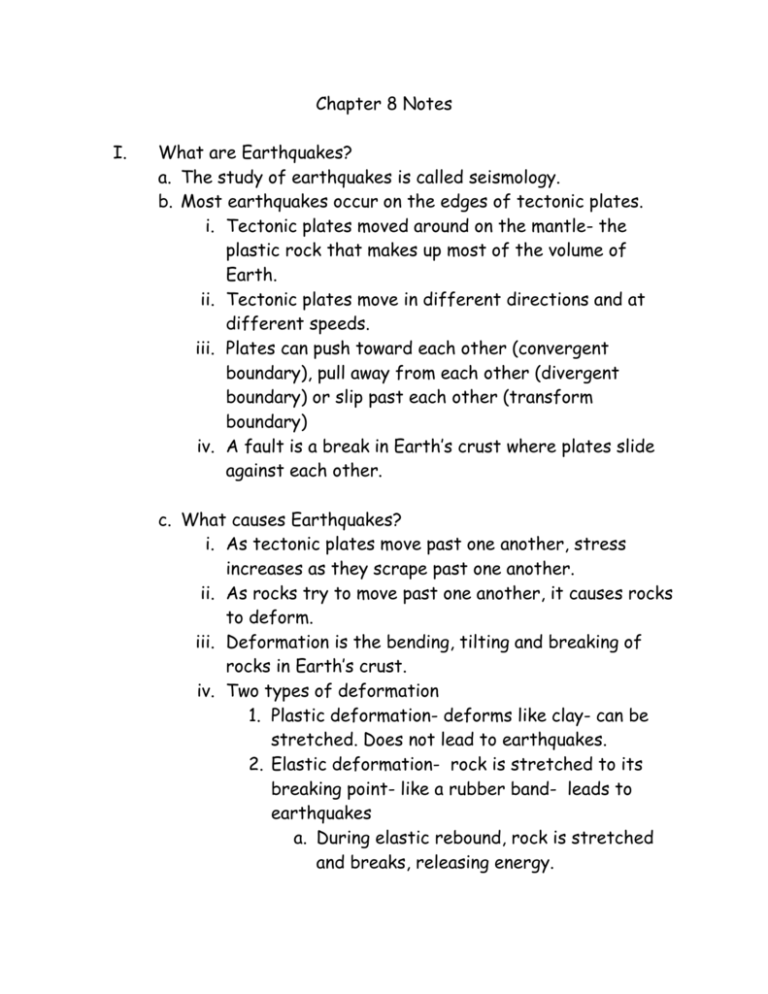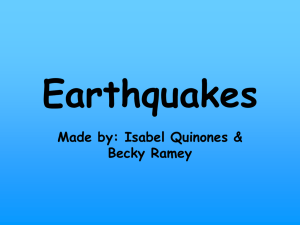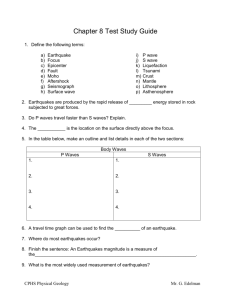Chapter 8 Notes What are Earthquakes? The study of earthquakes
advertisement

Chapter 8 Notes I. What are Earthquakes? a. The study of earthquakes is called seismology. b. Most earthquakes occur on the edges of tectonic plates. i. Tectonic plates moved around on the mantle- the plastic rock that makes up most of the volume of Earth. ii. Tectonic plates move in different directions and at different speeds. iii. Plates can push toward each other (convergent boundary), pull away from each other (divergent boundary) or slip past each other (transform boundary) iv. A fault is a break in Earth’s crust where plates slide against each other. c. What causes Earthquakes? i. As tectonic plates move past one another, stress increases as they scrape past one another. ii. As rocks try to move past one another, it causes rocks to deform. iii. Deformation is the bending, tilting and breaking of rocks in Earth’s crust. iv. Two types of deformation 1. Plastic deformation- deforms like clay- can be stretched. Does not lead to earthquakes. 2. Elastic deformation- rock is stretched to its breaking point- like a rubber band- leads to earthquakes a. During elastic rebound, rock is stretched and breaks, releasing energy. b. Some of this energy travels as seismic waves. d. Faults at Plate boundaries i. Transform Boundary= side to side motion= strike slip fault ii. Convergent Boundary= moving together= reverse fault iii. Divergent Boundary= moving apart= normal fault e. How to Earthquake waves travel? i. Waves of energy that travel through the Earth are called seismic waves ii. Body waves- waves that travel through the Earth’s interior 1. Two types a. P-Waves- also called primary or pressure waves i. Fastest wave ii. Move rock back and forth squeezing and stretching rock b. S- Waves- also called secondary or shear waves i. Arrive after P-waves ii. Cannot travel through liquids iii. Makes rock move side to side iii. Surface waves- waves that travel along Earth’s surface 1. Causes up, down and around motion along the ground II. Earthquake Measurement a. Seismographs- instruments located at or near the surface of the Earth that record seismic waves b. Seismogram- tracing of earthquake waves c. Determining time and location of an Earthquake i. Seismologists find an earthquakes start time by comparing seismograms and noting differences in arrival times of P waves and S waves to find the epicenter ii. Epicenter- the point on Earth’s surface directly above the starting point of the Earthquake. iii. Focus- the point inside the Earth where an earthquake begins. d. Measuring Earthquake Strength and Intensity i. Richter Scale- measures ground motion from an earthquake. 1. Each time the magnitude increases by one unit, the measured ground movement is 10 times stronger. 2. Ex. A 4.0 earthquake is 10 times stronger than a 3.0 3. Ex. A 5.0 earthquake is 100 times stronger than a 3.0 ii. Mercalli Scale- a measure of the degree to which an earthquake is felt by people and the amount of damage. 1. Represented by roman numerals








